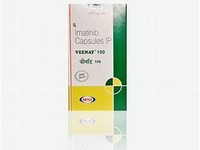imatinib
CLINICAL USE
Antineoplastic agent
DOSE IN NORMAL RENAL FUNCTION
400–600 mg daily, increasing to a maximum of 400 mg twice daily
PHARMACOKINETICS
DOSE IN RENAL IMPAIRMENT
GFR (mL/MIN)
DOSE IN PATIENTS UNDERGOING RENAL REPLACEMENT THERAPIES
IMPORTANT DRUG INTERACTIONS
Potentially hazardous interactions with other drugs
ADMINISTRATION
Reconstition
–
Route
Oral
Rate of Administration
–
Comments
–
OTHER INFORMATION
Associated with oedema and superficial fluid retention in 50–70% cases. Probability is increased in patients receiving higher doses, age >65 years, and those with a prior history of cardiac disease. Severe fluid retention (e.g. pleural effusion, pericardial effusion, pulmonary oedema and ascites) has been reported in up to 16% of patients. Can be managed by diuretic therapy, and dose reduction or interruption of imatinib therapySevere elevation of serum creatinine has been observed in approximately 1% of patientsOral bioavailability is 98% Main circulating metabolite is N-demethylated piperazine derivative, and has similar potency to the parent compound. Catalysed by cytochrome P450 CYP3A4. Mainly hepatically metabolised with 68% excreted in faeces and 13% in urine in 7 days. Half-life is 40 hours in normal renal function.
